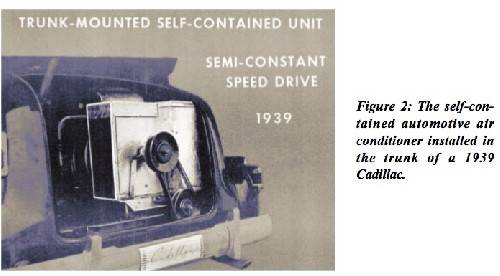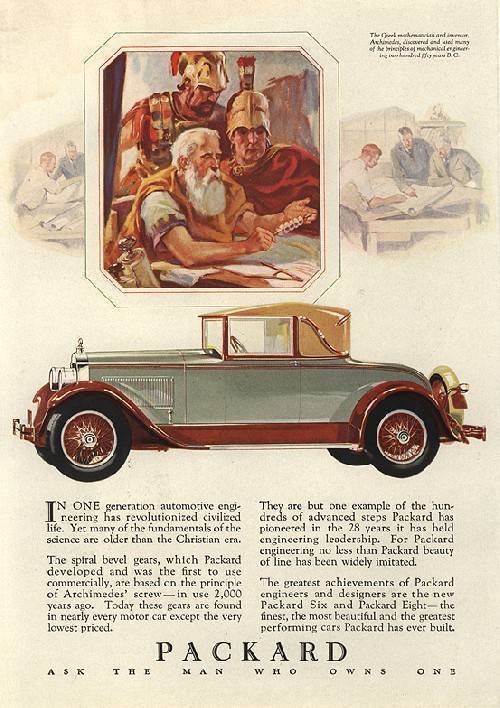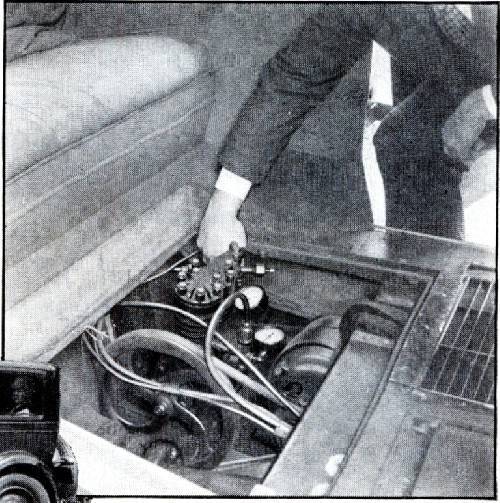|
Re: ice age
|
||||
|---|---|---|---|---|
|
Home away from home

|
Quote:
Gerd, Mal, many of the fundamentals of Packard engineering are older than the Christian era. In those days it was usual to consult witches. [picture source:onewhitecrow.posterous.com/archive/4/2009?page=18#!/]
Posted on: 2012/8/11 15:40
|
|||
|
The story of ZIS-110, ZIS-115, ZIL-111 & Chaika GAZ-13 on www.guscha.de
|
||||
|
||||
|
Re: ice age
|
||||
|---|---|---|---|---|
|
Home away from home

|
Quote:
Hi Steve, additional I missed a link to the original magazine and a date of issuance. Howard (HH56) brought me on the right track by mentioning 1933. The article dates from November 1933 and was published in "Modern Mechanix". Attach file:  (10.88 KB) (10.88 KB)
Posted on: 2012/8/11 15:51
|
|||
|
The story of ZIS-110, ZIS-115, ZIL-111 & Chaika GAZ-13 on www.guscha.de
|
||||
|
||||
|
Re: ice age
|
||||
|---|---|---|---|---|
|
Home away from home

|
Quote:
According to the article the comrepssor is driven by an electric motor powered by the cars generator. Looking at the lower rite photo it looks to me like an electric motor with pulley, Belt and flywheel on compressor. Article also indicaites possibility of a "special battery". Keith, thanks to Howard I found a pic with higher resolution which may helps to bring light into the darkness. Click to enlarge. [picture source Modern Mechanix Nov. 1933]
Posted on: 2012/8/11 16:01
|
|||
|
The story of ZIS-110, ZIS-115, ZIL-111 & Chaika GAZ-13 on www.guscha.de
|
||||
|
||||
|
Re: ice age
|
||||
|---|---|---|---|---|
|
Home away from home

|
"First Air-Conditioned Auto
With all windows sealed, and a stream of fresh, filtered air at just the right temperature entering through a special duct, the world's first air-conditioned automobile recently made its debut in a successful test run on New York City streets. It demonstrated a remarkable new system that promises all-the-year-round driving comfort, regardless of summer heat or winter cold. Air is drawn into this system through a concealed inlet, filtered to remove dirt and dust, blown over coils that chill or warm it as required, and admitted through grills to the car's interior. Cooling is effected by a refrigerating compressor beneath the floor boards, resembling that of an electric refrigerator, which takes its power from the car's generator or may be run from a special battery. To heat the air, hot water is circulated through the coils from the car's radiator. The air-conditioning equipment may be turned on or off at will from the instrument board or rear seat. Since the windows of the car are kept closed, outside noise is excluded. Any closed car, new or old, may have the air-conditioning system installed, according to the New York concern sponsoring the invention, which expects to manufacture it in the near future at a sufficiently moderate cost to permit its use even in low-priced cars. The makers foresee the car of the future provided with air conditioning as standard equipment. In that event many of the inconveniences encountered at present will be removed, along with a decrease in the danger of suffering carbon-monoxide poisoning." The degree of technical sophistication of this early prototyp is amazing. [source Modern Mechanix Nov. 1933]
Posted on: 2012/8/11 16:31
|
|||
|
The story of ZIS-110, ZIS-115, ZIL-111 & Chaika GAZ-13 on www.guscha.de
|
||||
|
||||
|
Re: ice age
|
||||
|---|---|---|---|---|
|
Home away from home

|
further information: -->studebaker-info.org/tech/aircon/ashrae.pdf
 natural air conditioner  Master Coolaire - simple water condenser sources pic #1: www.the.honoluluadvertiser.com pic #2: www.alte-reiseberichte.de
Posted on: 2012/8/11 16:40
|
|||
|
The story of ZIS-110, ZIS-115, ZIL-111 & Chaika GAZ-13 on www.guscha.de
|
||||
|
||||
|
Re: ice age
|
||||
|---|---|---|---|---|
|
Home away from home

|
"The technical sophistication of this early prototyp is amazing."
Actualy not. what surprises me is that very early gas or oil fired refrigeration units were rather common (relative to the fact that refrig was rather uncommon prior to the war) but never applied to automotive or other environments for human habitation. Back in the late 70's i tried to get AMC to develope a convection type AC for auto's. Of course i've always been one not afraid to press and issue past it's limits, sometimes way past limits. Long story short, after a very candid heart-to-heart little talk with chief eng'eer (he talked, i had to listen) and paraphrasing: i was told the big money of industrial America would never let it happen. And to now go back to my departement and punch some computer buttons.
Posted on: 2012/8/11 16:41
|
|||
|
VAPOR LOCK demystified: See paragraph SEVEN of PMCC documentaion as listed in post #11 of the following thread:f
packardinfo.com/xoops/html/modules/newbb/viewtopic.php?topic_id=7245 |
||||
|
||||
|
Re: ice age
|
||||
|---|---|---|---|---|
|
Forum Ambassador
|
Keith, heat is still an interesting idea and I know you have mentioned it more than once. It is funny there doesn't seem to be many attempts at coming up with something to get rid of the compressor with all the fuel efficiency work of the last few years -- or at least not much info if there has been.
One thing I'd be curious about would be the approximate physical size of the absorption unit components needed. Most of the smaller units can't handle much more cooling than an average well insulated refrigerator box and the typical solar units of decent capacity for residential are fairly good sized and expensive. It might be that both cost and size is still a big obstacle in why they are not considered in a car. Early AC into the 50's were fairly high capacity -- around 2 ton or roughly 24,000 BTU. Today, maybe around half that size with their better efficiency and insulated car bodies. At those sizes, might still be a fairly large amount of heat input needed for a decent output. Guess another question might be whether they have to run off a separate burner and would that fuel use negate any advantages or could they work with captured exhaust heat in a small enough package.
Posted on: 2012/8/11 17:34
|
|||
|
Howard
|
||||
|
||||
|
Re: ice age
|
||||
|---|---|---|---|---|
|
Forum Ambassador

|
what surprises me is that very early gas or oil fired refrigeration units were rather common (relative to the fact that refrig was rather uncommon prior to the war) but never applied to automotive or other environments for human habitation.
Two very large air conditioning systems that come to my mind prior to WW II were the huge dining rooms on the RMS Queen Mary of 1936 and SS Rotterdam of 1938. I've heard that they were ammonia systems powered by waste flue gases but have never been able to come across any real documentation. Carrier was very well-established by then, perhaps they were the supplier...? Again I digress....but some details on these large scale systems would be interesting, at least to me and perhaps to others. PS - the QM system is described as a "steam injection/vacuum evaporator" system, whatever that means.
Posted on: 2012/8/11 17:51
|
|||
|
||||
|
Re: ice age
|
||||
|---|---|---|---|---|
|
Home away from home

|
A convection type AC unit would be most desireable for vehicular applications since the exhaust heat or gas or oil firing could continue long after the engine shut down. Keeping the car cool while shopping in a store for maybe up to 30 minutes at least.
I am no HVAC expert by stretch of the imagination but my understanding is that refrig unit cooling effect is directly proportional to the condensor size more so thatn any other part of the system. Also my understanding is that the convection type AC units are very efficient and require nearly no maintenance for long periods of time. Most likely it is the maintenance charges to customers that the auto companies are looking for in terms of pump type AC units among other political agendas. One of the posts above shows a picture and describes a Cad with a household grocery refrigerator (if i read it rite) unit mounted in the trunk. Therefore: if a houshold kitchen refrigerator was good enuf for the Cad then why not such a similar coal oil fired houshold kitchen refrigerator???? Such oil fired refrigerators were fairly common, especialy in rural areas prior to the 1970's and common sized.
Posted on: 2012/8/11 23:02
|
|||
|
VAPOR LOCK demystified: See paragraph SEVEN of PMCC documentaion as listed in post #11 of the following thread:f
packardinfo.com/xoops/html/modules/newbb/viewtopic.php?topic_id=7245 |
||||
|
||||










